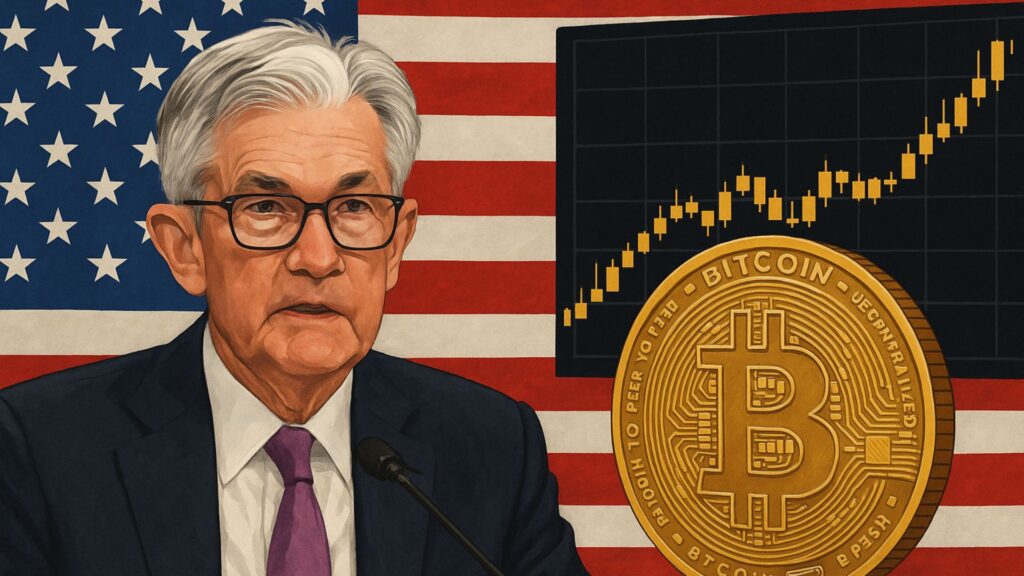Federal Reserve Chair Jerome Powell announced on May 7 that interest rates will remain at 4.25% to 4.50%, as the central bank adopts a cautious stance amid growing economic uncertainty.
While inflation has come down from its peak, it remains above the Fed’s 2% target. With slowing growth and new tariffs in play, many now fear the return of stagflation.
Grayscale argues this scenario could favour Bitcoin, comparing it to how gold performed during similar periods in the past.
Powell Holds Fed Rate as Inflation and Growth Show Signs of Stress
Powell emphasised during his latest press conference that the Federal Reserve is committed to its dual mandate of stable prices and maximum employment. The decision to keep the federal funds rate unchanged came as the economy faces conflicting signals.
While the labour market remains solid and job gains are steady, inflation remains above the long-term goal, and GDP growth has weakened.
Powell cited the recent slowdown in GDP as partly the result of temporary swings in net exports, likely due to businesses front-loading imports before tariffs took effect. He clarified that domestic demand, measured through private final purchases, rose 3% in Q1, matching last year’s pace.
However, household and business sentiment have dropped sharply due to uncertainty, especially around trade policy.
The Fed now finds itself in a delicate position. On one hand, it wants to avoid overtightening and stalling growth.
On the other hand, it must remain vigilant if inflation expectations begin to rise again. Powell made clear that the Fed will not rush to adjust policy until the data provides a clearer picture.
The new tariffs announced by the Trump administration, which are more severe than expected, add to the complexity. If sustained, they could increase costs, reduce growth, and raise unemployment, all classic ingredients for stagflation.
Powell acknowledged that the Fed might eventually face a scenario where its employment and inflation targets move in opposite directions.
If that happens, decisions will depend on how far the economy drifts from each target and how quickly either imbalance could be resolved. For now, the central bank will maintain its current stance, remaining open to adjustments as conditions evolve.
Grayscale Sees Bitcoin as a Safe Haven Asset During Stagflation
Grayscale, one of the leading digital asset managers, has suggested that the macroeconomic backdrop could be favourable for Bitcoin over the medium term.
In their recent note, they explain how tariffs may increase inflation while simultaneously slowing growth, creating a stagflation-like environment.
Historically, this has been negative for equities and bonds but positive for scarce commodities like gold.
Bitcoin was not around during the stagflation of the 1970s, but Grayscale argues that it now shares several traits with gold. It is limited in supply, increasingly viewed as a store of value, and less tied to national currencies.
Grayscale highlights that although Bitcoin’s price fell after the April 2 tariff announcement, the decline was relatively modest when compared to traditional assets.
They also point out that while the S&P 500 fell around 12% after the news, Bitcoin’s drop was closer to 10%. Considering Bitcoin’s typically higher volatility, this smaller decline is notable.
It suggests that Bitcoin may be acting more like a resilient asset during market stress, offering some level of diversification.
Beyond the near term, Grayscale believes that tariffs and trade friction could weaken global demand for the US Dollar, especially if trade flows decline.
This would reduce transactional demand for the currency and potentially accelerate moves by central banks to diversify their reserves.
While Bitcoin is not yet widely held by central banks, Grayscale notes growing interest, including exploratory steps by institutions such as the Czech National Bank.
Meanwhile, domestic policy in the US is becoming more favourable towards digital assets. Regulatory pressure has eased in 2025, and financial institutions have been granted more room to engage with crypto.
These developments, combined with macroeconomic shifts, could broaden Bitcoin’s appeal and position it as a long-term alternative asset.
Grayscale stops short of making a price prediction but draws clear parallels to gold’s performance during past economic downturns.
If inflation remains elevated and growth continues to soften, Bitcoin may attract greater attention from investors seeking protection outside of traditional markets.
Conclusion
Powell’s decision to hold interest rates steady reflects a cautious Fed watching inflation, employment, and trade policy developments closely.
As tariffs reshape the economic landscape, fears of stagflation are rising. Grayscale’s analysis suggests that Bitcoin, with its scarce supply and improving market infrastructure, could benefit in this scenario.
While the future remains uncertain, one thing is clear, investors are preparing for a more volatile economic cycle. For those exploring crypto as part of that preparation, platforms like Bitrue offer an accessible starting point.

